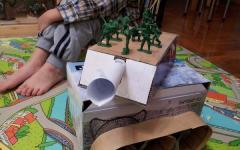In the final knitting stage, we often think how beautiful and strong connect knitted parts... The easiest way is to attach it with a special needle with a large eye, but you can also knit a seam with a regular crochet hook.
So how do you neatly crochet the pieces?
Connecting parts with half-columns without a crochet

We fold the two parts of the product to each other with the front sides. We insert the hook into the loop of both parts, grab the working thread and pull it through both loops, while observing the minimum tension.
Connecting parts with single crochet

We fold the two parts of the product to each other with the front loops, or the wrong ones, so that the seam is visible. We knit in the same way as in the first method, only instead of half-columns we use
Connecting parts with single crochet and air loops

We knit single crochet and air loops alternately. Such a seam is used when the parts are small, as well as if the product needs to be more elastic.
Flat connection of parts with half-columns without crochet

We fold the parts of the product with the edges to each other seamy side up. We knit through the corresponding loops.
Other ways of connecting with half-columns without a crochet

In this way, effectively connect crocheted stripes and knitted fabric squares. Such a connection is quite simple, it sets off patterned surfaces well.
First, connect two squares on one side: * knit 1 st. With a crochet from the bottom square, 1 st. With a crochet. from the top square, 2 VP *.
thus knit from right to left. From the connected quadrangles, stripes are obtained. The strips are interconnected along the longitudinal edges: * knit 1 tbsp. with nak. from the bottom band, 1 tbsp. with nak. from the top band, 2 VP. *
At the junction, knit 1 tbsp. with nak. from the corners, 2 VP, 1 st. with nak. from the middle of an already completed connection, 2 VP, 1 tbsp each with nak. from the corners.
Such a connection is very decorative, it hides well the not very even sides of the squares.
Tie the square as follows: * 1 tbsp. without nak., 5 VP *. In the corners knit 1 tbsp. without nak., 7 VP, 1 st. without nak. When tying the next square, attach one of the sides to the last square: * 1 tbsp. without nak., 2 VP, 1 connecting st. for the arch from the VP of the opposite side, 2 VP *. In the corner, knit 1 tbsp. without nak., 3 VP, 1 connecting st. from the 4th VP of the last square, 3 VP, 1 tbsp. without nak.
The 3rd square, when tying, is attached to one side of the 2nd square.
The 4th square is attached with one side to the 3rd, the other side to the 1st square.

This is a very narrow and conspicuous connection. When knitting large items in this way, you can connect the parts with a ladder.
Tie the square as follows: * 1 column without nak. 2 VP *. In the corners, knit 3 VP between the columns without a crochet. Perform two sides at the same time with the following squares: knit 1 tbsp. without nak. from the 1st square, 1 VP, connect the 4th square in the same way with the last quadrangles. In the corner, perform 1 tbsp. without nak., 1 VP, 1 connecting st. from the middle VP of the last corner arch, 1 tbsp. without nak.

This joint is suitable for open mesh edges and patterns that require a border. In this way, it is very good to connect the parts with a ladder.
Tie the square as follows: 2 unfinished sts. with a crochet, knitted together, 2 VP. In the corner, knit 2 unfinished double crochets, knitted together, 5 VP, 2 unfinished sts. with knitted together. Connect the two sides like this: * knit together 2 unfinished sts. with nak. from the 1st square, 2 unfinished st. with nak. knit together from an adjacent square, 1 Bp *. Also connect the 4th square with the last quadrangles. In the corner, knit 2 unfinished sts together. with nak., then - 2 VP, 1 connecting st. from the middle VP of the last corner arch, knit 2 unfinished sts together. with a crochet.
Three ways to connect motifs - crochet
Recently, plaids associated with motives have become very popular. Knitting them is easy, and the beauty and coziness that they create in the house is difficult to replace with something else.
However, a good blanket should differ not only external beauty but also good functionality. It should be cozy, warm, soft, and at the same time keep an elegant and neat look with constant use for its intended purpose.
To achieve this, you need to know a few simple rules, namely: how to choose the right yarn for a blanket, and how to neatly and reliably connect the motifs to each other when knitting it.
This is what the wonderful master class of Elena Bozhkova is dedicated to, with which I want to introduce you.
“In connection with numerous questions, I decided to collect methods of combining motifs in one post, and also tell me what yarn and crochet hooks I choose for knitting blankets. I warn you, my opinion is personal, it is based only on my preferences and personal experience, and of course, may differ from yours.
There are a great many methods of combining motives, but I will only talk about those that have been tested by me personally.
First way: in advance related motives are interconnected with ordinary single crochet posts by the edges of both parts (motifs)




According to this principle, the motives of the following blankets presented in the photographs are connected:




Second way: Very similar to the first, the motifs are also connected with single crochet, but only the motifs are connected at the back walls of the loops, in this case the connection is flatter ...
Here is a visual connection in this way:


Third way: motifs are connected to each other in the process of knitting, with single crochet in the last row of the attached element




The products shown in the photos below are connected in this way:




Now about yarn and crochet hooks :) Attention! My opinion is personal, it is based only on my preferences and personal experience, and naturally, it may differ from yours. Personally, I do not advise choosing woolen, semi-woolen yarn, etc. for knitting blankets and bedspreads. Products made from them are not durable and unpredictable in such products as blankets, bedspreads and pillows, spools often appear if the products are used for their intended purpose, and not for beauty :). Better to dwell, in my opinion, on cotton with the addition of acrylic. Natural cotton is also not bad, but the acrylic in the yarn makes the product more wear-resistant and does not deform. I also like to knit blankets from special acrylic yarn for babies. The yarn, according to the manufacturer, is anti-allergenic and can be used for children of any age. It is very soft, light and warm.
I checked all the yarn from which my plaids are knitted by washing in washing machine on the “wool” or “delicate” mode, using a liquid for washing woolen and delicate fabrics. The products did not deform or shed. Dried unfolded in a horizontal position. Also, ironing is possible - through the iron, using steam.
Regarding the choice of the number of the hook ... I, most often, when knitting blankets, I use No. 3, No. 3.5. But it all depends on the thickness of the yarn that you choose.
I hope I was useful to you. "
http://crocket.moya-kopilochka.ru/
Before you start knitting clothes from square motives, find suitable model... Pay attention to the photographs of motives - they often look beautiful, but in fact the motive turns out to be rough or irregular in shape. Try to knit one motif using the recommended yarn (listed in the model description) and one that you like in the store.
In general, there are several ways to connect crocheted square motifs. The first way is to join by stitching motifs; the second is knitting the last row of the square and simultaneously connecting it with another motive.
Method one: stitching square motifs
Sewing square motifs together after making the required amount is enough in a simple way connections. The only negative is the roughness of the seams between the squares. If you just want to sew clothes, then it is better to take a thinner thread, and the connecting stitches do not need to be tightened too much.
It should be noted that it is best to use the forward stitch. Such a stitch will not allow the stitched motifs to skew even with prolonged use of the thing, as well as with front side practically will not be noticeable. When sewing, you should not make large knots, securing the thread - while wearing the product, the knots will rub the skin, causing discomfort.
Method two: connecting motives with a hook
The most durable and beautiful connection of motifs can be achieved by tying the last rows of elements. This is done like this: first you completely knit one square, then make another, but only until the penultimate row. In the final row, you will need to knit a square according to the pattern, and also connect it with the previous motive. With connecting posts (knits like a single crochet, only the thread is pulled through both loops at once) the seam between the elements will not stand out much.
If you want to make the seam almost invisible, then you will need to stretch the loop obtained when knitting the connecting post into the edge of the previous element.
Choose a method of joining square motifs, depending on what type of yarn you are using, as well as what kind of thing you are knitting. For example, if you want to make a knitted blanket from thick warm yarn, it is better to sew the elements together. When making a lung summer dress ideal option would be
From crocheted motifs, you can create not only napkins, tablecloths, bedspreads, but also evening dresses, warm capes-ponchos, light sundresses-flounces and other interesting things. The main thing is to correctly and cleanly connect the parts so that the strike does not spoil the appearance of the product. There are many options for fastening motives, we will consider the most popular.
How to connect crochet motifs - an easy way
It will not take much time to strike the fragments with connecting posts, but in this case the seam turns out to be rather rough and at the end of knitting it is better to steam it off with an iron.
- Fold the two motifs inside out.
- Crochet the 2 cornering stitches of the parts and pull out the working thread.
- Pull in. n. lifting and connect the workpieces st. b / n, introducing the hook into the next loops of the motives.
This method of joining parts is used when knitting blankets, pillowcases, rugs.
How to connect crocheted motifs - fantasy variation
You can collect the “grandmother's” squares into a single piece of cloth using a fancy mesh, which is tied between the motives. This fastening is suitable for almost any product, be it a fashionable blouse, openwork scarf or a summer handbag. Progress:
- fasten the thread at the corner of the first motif and pull 3 v. NS.;


- connect the chain with the second motif using 2 tbsp. s / n;


- further - 3 tbsp. s / n knit in the 1st square;


- tie motifs with three double crochets to the end of the details;


- collect the segments in horizontal strips in the same way and tie them together in the same way.


Rinse the resulting item in warm water, dry it, iron the joints and - use it.


How to connect crochet motifs while knitting
Finish the main drawing of the first motive and when knitting the outer row of the 2nd element, follow the instructions:
- insert the hook into the 1st motive and knit 3 double crochets;
- work with the 2nd element in the same way until the next connection point;
- tie 3 tbsp. s / n and fasten in a similar way all the squares until the end of knitting.
Usually, the connection points are marked on the diagrams, but if you are doing your own pattern, tie 2 fragments and estimate the attachment points.


How to connect crochet motifs with a needle
It is easy to turn small knitted details into a bright blanket or a colorful pillow using a sewing needle and thread in the color of the motifs.
- Over the edge seam. Fold 2 motives face to face. Insert a needle and thread into the upper right corner. Sew passing the stitches through the back of each buttonhole of the seam edges. Then add the next piece and grind off the touching sides.
- Blind seam. Place the squares next to each other, right side out. Pull the thread from the bottom up under the loop of the right fragment, then the left one. When you reach the end of the row, tighten the thread so that the edges close together.


There are many ways to combine motives. Choose for yourself how it is more convenient for you to collect the canvas and embody your ideas, adding a special unique charm to knitted things with a beautiful connection.









